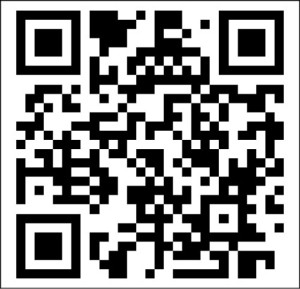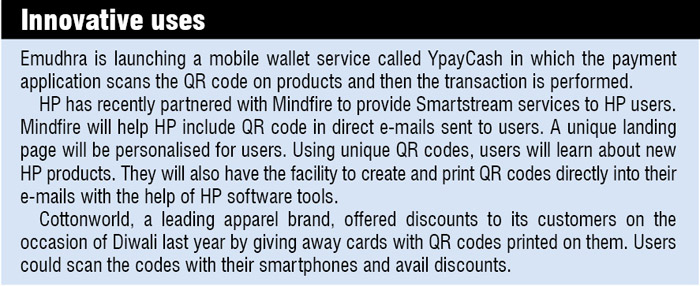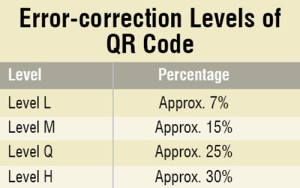
Quick response (QR) codes are among the latest in the stable of marketing tools. These have been devised to effectively bridge the gap between offline and online marketing. QR code was created by Toyota’s subsidiary Denso Wave in 1994 to track vehicles during the manufacturing process and was initially confined to the automotive industry. With the evolution of smartphones, users got a mobile QR code reader in their pocket, which they could use to scan and read QR codes easily.
What is it?
QR Code, a registered trademark of Denso Wave Inc., is an enhancement over the conventional bar codes placed on objects such as product packaging or containers.
Bar codes store a smaller amount of information than QR codes because these store information only in the horizontal direction. A barcode scanner reads only the width and space between vertical lines and the vertical space (second dimension) is wasted.
In QR codes (2D codes), information is stored in both vertical and horizontal directions. So these can store the same amount of data as a bar code in only a tenth of the space. A QR code may contain a huge amount of complicated numeric, alphanumeric or binary data. Storing up to 4296 characters, QR codes are internationally standardised under ISO 18004.
The technology of dots
The smallest square dot or pixel element of a QR code is called a module. As with bar codes, it is recommended to have an empty area around the graphic, which makes it easier for devices to read the QR code. This quiet area is ideally four modules wide.

The minimum dimensions of a QR code depend upon the resolving power of the cameras that are used to scan the code. According to a Kaywa whitepaper, it is recommended to use a minimum size of 32×32 mm2 (1.25×1.25 inch2), excluding quiet zone, for QR codes that contain a URL. This guarantees that all camera phones can properly read the QR code. The above rule applies to perfectly printed codes that the user has direct access to.
For good reader accuracy, good contrast between the background and the dots colour is very important. The dots should be dark in colour and placed on a light background. The printing specifications of a QR code recommend a high dpi and solid colours.
How it works
A QR code system includes a QR code printer and a QR code scanner. To generate QR code, one needs a special printer and QR code creation software. Applying the right size to the QR code is important to make the code readable.
There are various factors which should be considered while determining the size of a QR code: Symbol version, data capacity, character type, error-correction level and module size based on printer performance.
Symbol version. QR codes have symbol versions from 1 to 40. Each version is differentiated by the number and configuration of modules. ‘Module’ refers to the B&W dots that constitute a QR code. Each version has a maximum data capacity that is decided by the amount of data, the type of characters (numeric, alphanumeric, etc) and the error-correction level. So the more the data stored, the bigger the size of the QR code.
Error-correction level. QR codes have four levels of error-correction capability, viz, level L, M, Q and H in ascending order. With error correction, the user can read and retrieve data from a damaged QR code.

Error correction is a trade-off with the amount of data that can be stored. For two QR codes of the same size, the one with the lower error-correction level will store more data than the one with a higher level.
The error-correction levels can be chosen as per the usage environment. For instance, if the QR code is to be used in a factory to track batches, more error correction (level H) is required. On the other hand, in a clean environment such as a print magazine, level L can be used.
QR codes for marketing
 QR codes provide a convenient one-step process for directing users to a website, phone number, promotions or other information. Besides, these are environment-friendly as they make an efficient use of the printed material. Creating them costs virtually nothing when used in a number of versatile marketing and advertising instruments such as print ads, brochures, visiting cards and event displays.
QR codes provide a convenient one-step process for directing users to a website, phone number, promotions or other information. Besides, these are environment-friendly as they make an efficient use of the printed material. Creating them costs virtually nothing when used in a number of versatile marketing and advertising instruments such as print ads, brochures, visiting cards and event displays.
Measuring a marketing campaign. A marketing campaign becomes redundant if there is no tool to track its effectiveness. Using QR codes, it is easy to track and measure marketing campaigns with the help of Web analytic tools.
If used effectively, the advantages of QR code can be harnessed by any organisation that caters to a smartphone-using target audience—be it a retail business, a non-profit organisation, a membership association or an educational institution.
Sharing. A QR code can be used to share a video or a landing page. It contains enough alphanumeric characters to link to a website. So it can display the download link of an app, which, in turn, can promote your business.
Community. Applications can be used to create QR code that links to a social networking functionality such as ‘Like’ button of a community page on Facebook.
QR codes can be used in visiting cards and on products to include information such as price and manufacturing details. These can contain a lot of information such as the location of your business and the category of products you offer. They can also be used in an innovative way for linking to application installation links, customer feedback forms, locations on Google Maps, etc. You can track your customers using QR codes and find out where the purchase was made.
Major airlines have been using QR code in their air tickets. Also, while registering with Google Places, you get a QR code linking to the website.
Disadvantages of QR codes
Any new technology has its own set of problems that calls for attention and subsequent solutions. In the case of QR codes, it has been argued that they may not work due to the very nature of the technology. The very purpose of QR codes is to encrypt data within the code, which provides scope for cyber criminals to cloak smartphone attacks. There is no way to know whether the code is genuine and links to a legitimate website or an infected one, a malicious app or a phishing site.
A type of infected QR code downloads an app that introduces a hidden texting charge in your monthly cellphone bill. QR codes can also be used to gain full access to a smartphone—including Internet access, camera, GPS, read/write local storage and contact data. All the data on a smartphone can be stolen by remotely transferring it, putting the user at the risk of identity theft.
QR code in India
A Google Trends report on search patterns for QR codes puts India at the eighth place in the world. In India, one of the first companies to use QR code in advertising was Ford, which used it to promote Ford Figo. Users were asked to download an application that read QR code by sending a text message. They could then play a video of the Figo on their mobile device.
Marketing companies such as Customer Centria have used QR codes in promotional campaigns of Godrej’s social networking site GoJiyo and Taj Hotel’s holiday packages.
Some Indian portals such as www.flick2know.com provide free generation and implementation of QR code.
The future
QR codes are a wonderful marketing tool if used effectively. These should be carefully and cleverly placed and used to the advantage of the marketer. A QR code is not effective if it doesn’t lead to mobile-friendly content. Placing QR codes on billboards where traffic moves fast makes it impossible to stop and scan. Their use in subway platforms where there is no signal also makes them redundant. When used in fliers, banners, etc in an event, it is essential to have WiFi or other Internet access at the venue.
As of now, QR codes require connection to the Internet to give information. We await the arrival of QR codes that can store much more data than the present generation and don’t require an Internet connection to furnish that.
Niraj is IT administrator at EFY and Ashish is content development executive for www.electronicsforu.com






